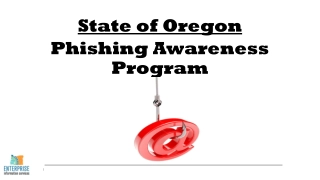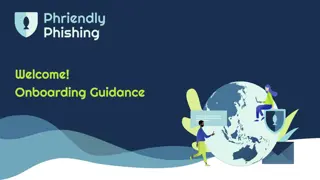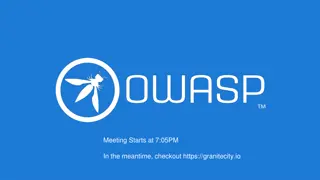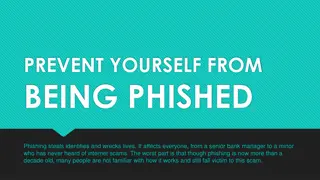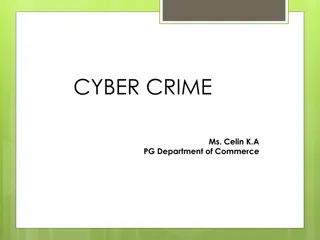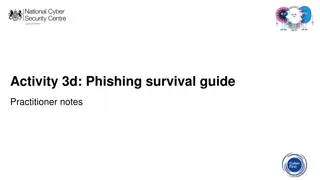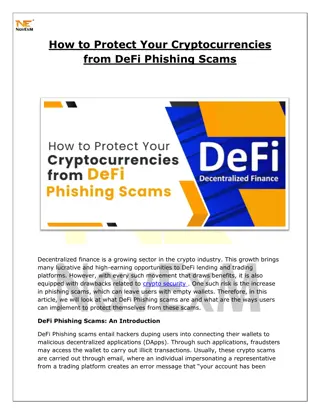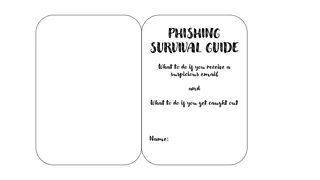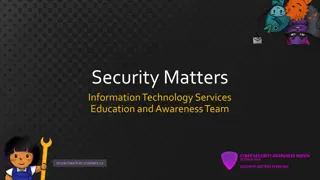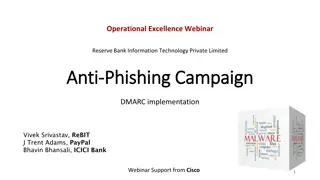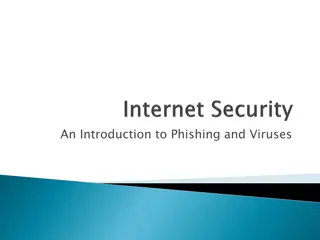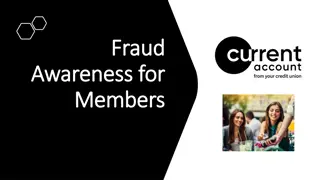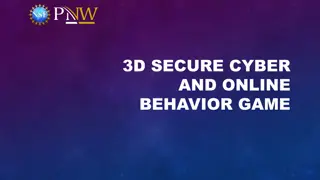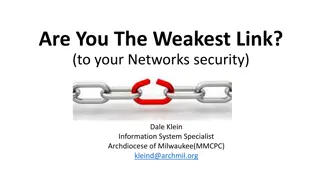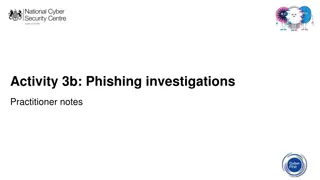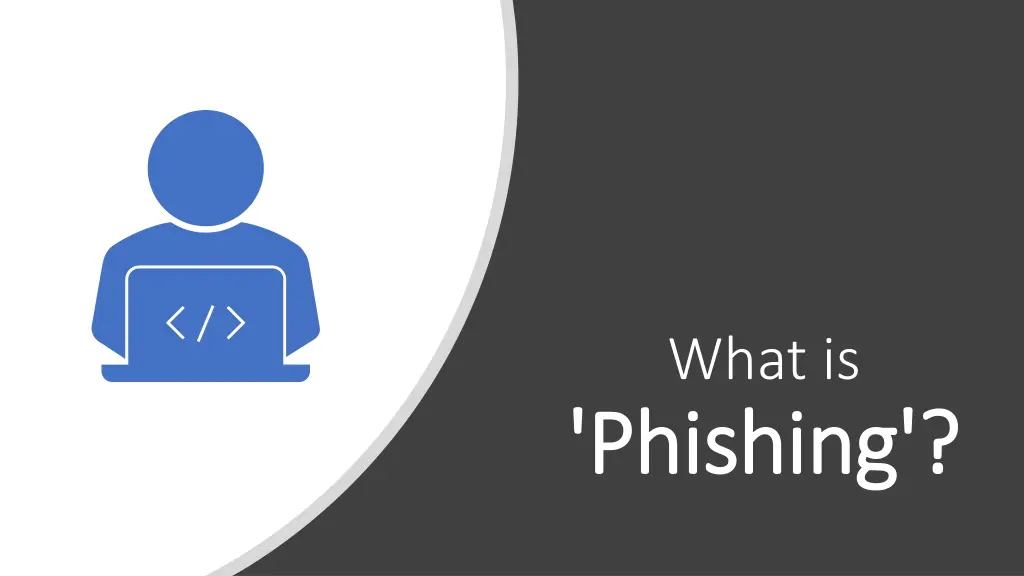
Understanding Phishing: The Most Common Cyberattack Method
Phishing is a prevalent form of cyberattack where fake emails or texts are sent to trick individuals into revealing personal information like passwords and credit card numbers. Learn how to spot phishing attempts and protect yourself from falling victim to such scams.
Download Presentation

Please find below an Image/Link to download the presentation.
The content on the website is provided AS IS for your information and personal use only. It may not be sold, licensed, or shared on other websites without obtaining consent from the author. If you encounter any issues during the download, it is possible that the publisher has removed the file from their server.
You are allowed to download the files provided on this website for personal or commercial use, subject to the condition that they are used lawfully. All files are the property of their respective owners.
The content on the website is provided AS IS for your information and personal use only. It may not be sold, licensed, or shared on other websites without obtaining consent from the author.
E N D
Presentation Transcript
What is 'Phishing'? 'Phishing'?
Common Cyberattacks Malware Password Attack Man-in-the-middle Phishing Unwanted software that is designed to disrupt, damage, or gain unauthorized access to a device or network The most obvious kind of "hack". It involves guessing passwords, or using known passwords from database breaches (Example: Yahoo in 2016) The classic "Hollywood" style of hacking, where a hacker is able to intercept sensitive information by gaining access to a device or network. A type of social- engineering attack that tries to get the user to reveal personal information by posing as an authority. Somewhat Common Somewhat Common Very Rare Very Common Includes Ransomware, Spyware, and other Viruses Includes Brute-Force Attacks, Dictionary Attacks, and using passwords from database breaches Includes gaining total control over your device, or passively intercepting sensitive information. Utilizes emails and texts to pose as an authority in an attempt to get you to click a link and enter sensitive information.
What is 'Phishing'? 'Phishing'? Phishing is quickly becoming the single most common form of cyberattack because... Phishing is the practice of sending fake emails or texts, purporting to be from an authority or reputable company, in order to obtain personal information, such as passwords and credit card numbers. It requires very little effort or pre-planning It allows attacks on a large number of victims at once It specifically targets the weakest link of any security system: its people.
Phishing can take a number of forms, most commonly as emails or texts. Often, they will include the following types of content: Phishing can take many forms... "Your account is locked" "Unusual activity detected on your account" "Your password must be reset" "Your payment is pending" "You are owed a refund" The idea here is to trick you into clicking a link within the email, where you'll be asked for your login info or your credit card number. DO NOT CLICK THE LINK.
The best way to prevent a successful phishing attack is to learn how to spot them. Here are some steps to follow: Step 1: Don't panic. Phishing attacks often work because they prey on our emotions. "Getting hacked" can be scary, and the emails are specifically designed to convince you that you are currently under attack, or that someone has already gained access to your personal information. Step 2: Identify the content Phishing attacks generally contain the same types of content. Namely, that your account is locked, your password must be reset, or payment must be given or received. You should be wary of any email that contains this type of content. Step 3: Identify the sender. By far the easiest way to identify a phishing attack is to check the actual email address of the sender, as we'll see in the next slide... How to spot a phishing attack
Let's look at an example. Here are two emails from an email inbox. One is real, the other is fake. How can we tell? Let's follow our steps... Step 1: Don't Panic Seeing that my Netflix account might be locked or hacked can be scary, but because I know about phishing emails, I'm going to look a little deeper before I start to panic. Step 2: Identify the content Let's open the second email and see what it looks like. Because I know that phishing emails generally contain the same type of content, I'm wary of any email that asks me to update my payment details. Step 3: Identify the sender Finally, I want to identify the sender of the email, because even though it says "Netflix" in my inbox, that might not be the actual email address that was used. So let's check. When I open the email, at the top left I can see who sent it by looking at the actual email address. The email address looks nothing like "netflix.com", so I know it must be fake.
What is 'Spear-Phishing'? Spear-Phishing is a particularly sophisticated phishing attack that is specifically tailored for its victim. Someone utilizing this approach will collect detailed information about their victim before attempting their attack. For example, an attacker may try to pose as your supervisor, or even the head of the company, in an attempt to gain your information or induce you to purchase something for them. Although these types of attack are very rare, they are also much more sophisticated, and therefore more dangerous. In any case, you can spot these emails by using the same techniques as before. In particular, this type of phishing can be spotted by double checking the actual email address of the sender to see if it exactly matches the one you are expecting Be careful! Because these are targeted attacks, the fake email address is likely to very closely resemble the actual real email address that they are trying to impersonate!
If you think that there is even the smallest possibility that an email you received may be a phishing attack you should... Follow the 3-Step Process: Step 1: Don't Panic Step 2: Identify the content Step 3: Identify the sender Report the email as a phishing attack In Outlook, you can report emails as phishing attacks by clicking on the three dots at the top-right of the email. Find the option in the dropdown labeled "Report", then select "Report phishing" This removes the email from your inbox, and also helps Outlook in automatically identifying potential phishing attempts in the future. Some email providers may not have this option, but will instead allow you to "Mark as Spam" which does pretty much the same thing. If you believe that the email was an attempt at Spear- Phishing, instead of a standard phishing attack, you should tell your supervisor as soon as possible. What should I do if I... get a a phishing phishing get email email?
No one is completely immune to phishing attacks, and even cybersecurity experts sometimes fall for even the most basic phishing attacks. Why? Because humans will eventually make mistakes, and phishing attacks are meant to prey on that inevitability. If you believe you've fallen for a phishing attack, you should... Change your password for the affected service (Netflix, Online Banking, etc.), as well as any other services that may use that same password. Contact your supervisor and inform them immediately. In particular, if you believe this was an attempt at Spear-Phishing rather than a standard phishing attack, you should escalate the situation as quickly as possible to limit the potential damage. What should I do if I... fall for a phishing a phishing fall for email? email?
PHI and Encrypted Email PHI and Encrypted Email 'PHI' is 'Protected Health Information', and any emails containing PHI must be encrypted, by law. Encryption ensures that our data assets remain safe even if they are Encryption ensures that our data assets remain safe even if they are intercepted. intercepted. At Alberta, any email sent from your @albertaps.com email address will automatically be encrypted whether it contains PHI or not.


